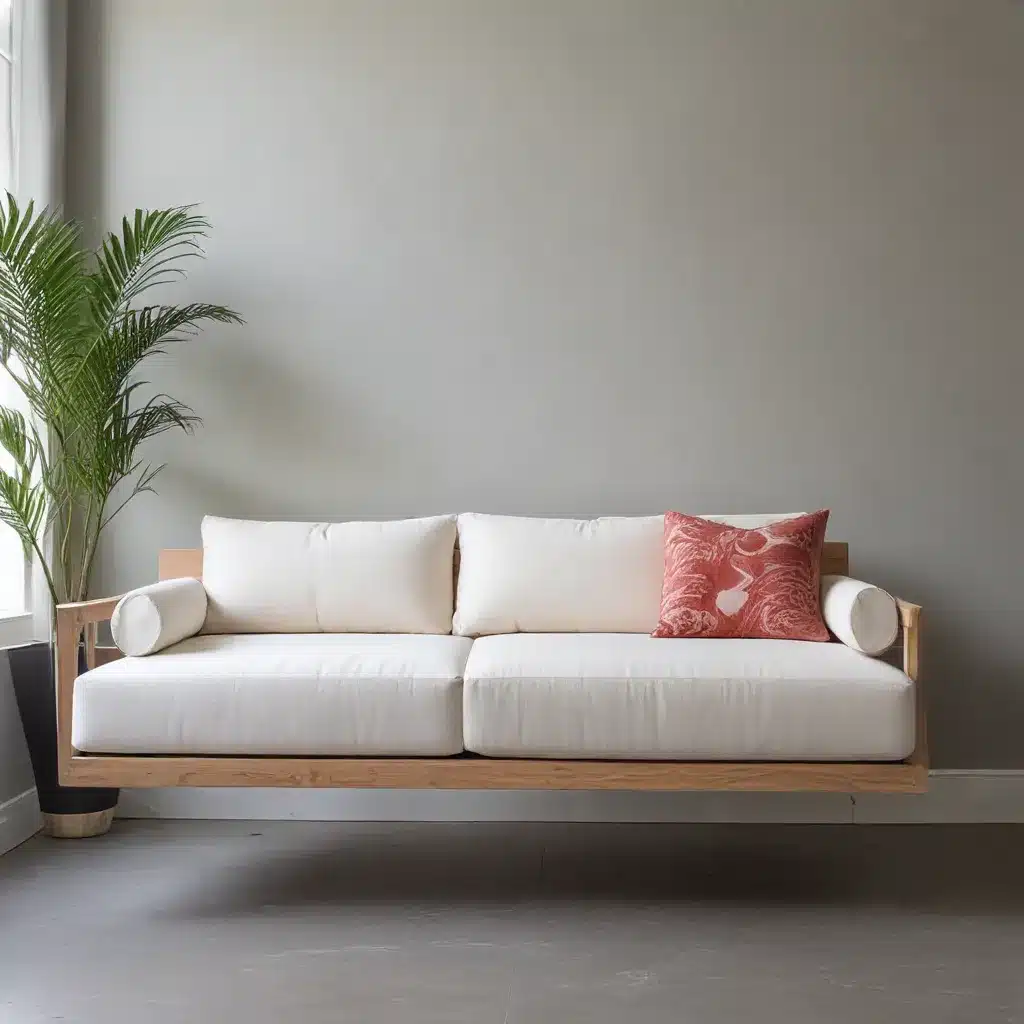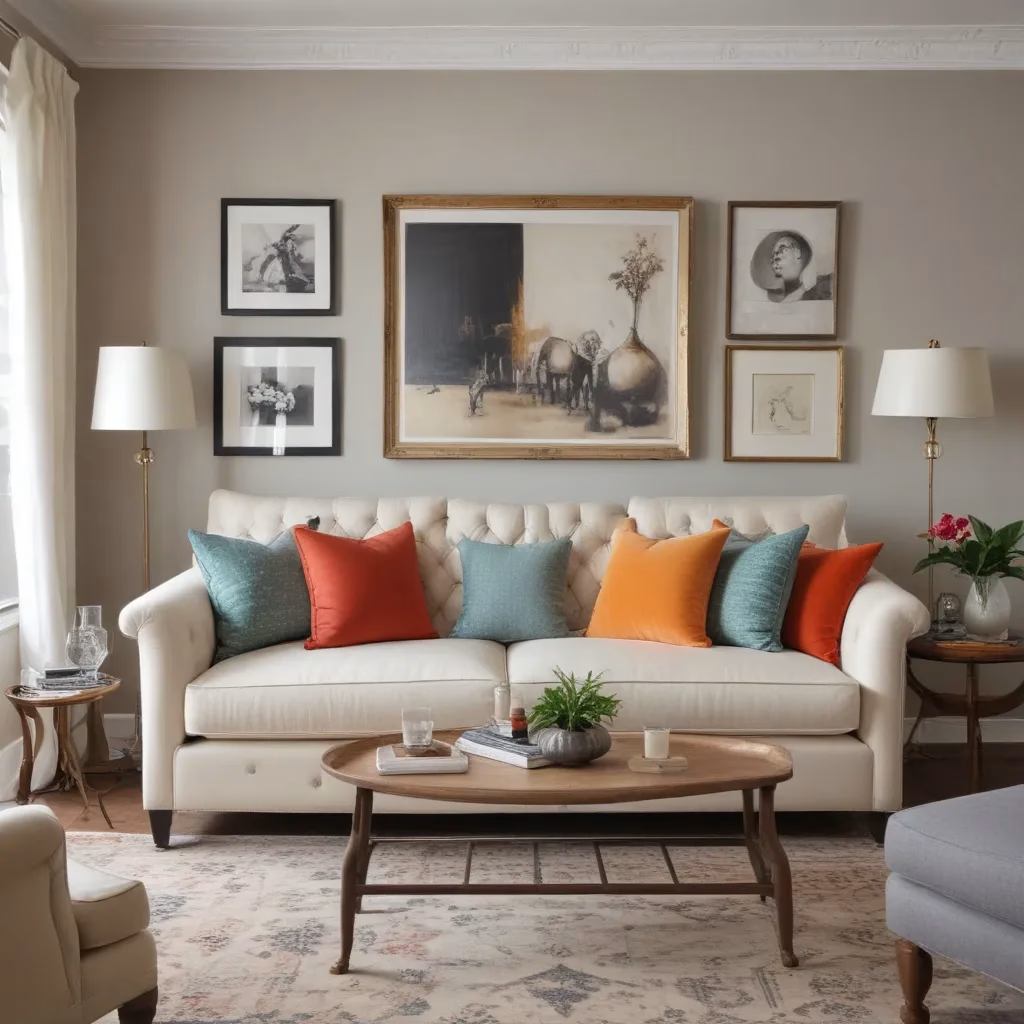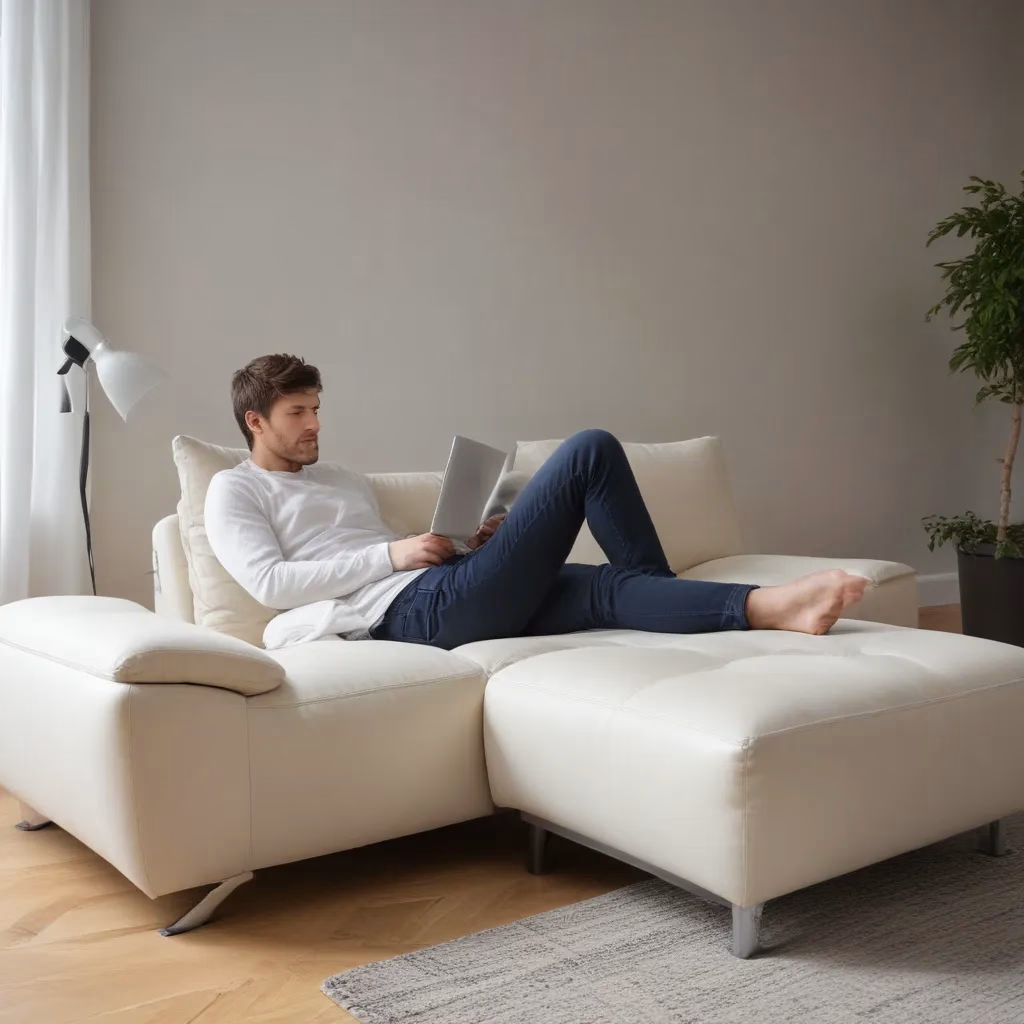
As a furniture specialist with years of experience in the industry, I’ve seen countless trends come and go. However, one style that continues to captivate homeowners and designers alike is the minimalist aesthetic, particularly when it comes to sofas. Today, I’m excited to share my insights on a project that’s been gaining popularity: the DIY floating sofa.
The Appeal of Floating Sofas
Floating sofas have become increasingly sought-after in modern interior design. Their sleek, elevated appearance creates an illusion of more space, making them perfect for smaller rooms or open-concept living areas. As someone who’s worked extensively with various sofa styles, I can attest to the transformative power of a well-designed floating sofa.
The minimalist nature of floating sofas aligns perfectly with the current trend towards simplicity and functionality in home decor. By opting for a DIY approach, you not only save money but also gain the satisfaction of creating a custom piece that fits your space perfectly.
Benefits of Choosing a Floating Sofa
- Visual lightness: The elevated design makes your room appear more spacious and airy.
- Easy cleaning: With space underneath, vacuuming and mopping become much simpler tasks.
- Versatility: Floating sofas work well in various design styles, from ultra-modern to transitional.
Planning Your DIY Floating Sofa Project
Before diving into construction, it’s crucial to plan your project meticulously. As someone who’s guided numerous clients through furniture selection and placement, I can’t stress enough the importance of this phase.
Measuring and Designing
Start by measuring your space carefully. Consider not just the dimensions of the room, but also the flow of traffic and the placement of other furniture pieces. I always advise my clients to use masking tape on the floor to outline the proposed sofa dimensions – it’s a simple trick that can save you from costly mistakes.
When designing your floating sofa, think about:
- The desired seating capacity
- The height of the sofa from the floor
- The depth of the seat for comfort
- The overall style and how it will complement your existing decor
Remember, the beauty of a DIY project is the ability to customize. You’re not limited to standard sizes or shapes, so feel free to get creative!
Choosing Materials
Selecting the right materials is crucial for both the aesthetics and durability of your floating sofa. In my experience, a combination of sturdy wood for the frame and high-quality upholstery fabric yields the best results.
For the frame, consider using:
- Pine or fir for a budget-friendly option
- Oak or maple for a more premium look and increased durability
When it comes to upholstery, factors to consider include:
- Durability (especially important for households with children or pets)
- Ease of cleaning
- Color and texture that complement your decor
I’ve found that performance fabrics are increasingly popular for their stain-resistant properties and longevity. However, if you’re aiming for a luxurious feel, nothing beats the timeless elegance of leather.
Step-by-Step Construction Guide
Now that we’ve covered the planning phase, let’s dive into the actual construction of your floating sofa. As someone who’s overseen countless furniture projects, I can assure you that with patience and attention to detail, this is a achievable for most DIY enthusiasts.
Building the Frame
- Cut the wood: Using your measurements, cut the pieces for the base, backrest, and arms (if desired).
- Assemble the base: Create a rectangular frame for the seat, ensuring it’s sturdy enough to support weight.
- Attach the backrest: Securely fasten the backrest frame to the base, checking for stability.
- Add support: Install additional bracing as needed to prevent sagging over time.
Creating the Floating Effect
The key to achieving the floating look is in the support structure. There are two main approaches:
- Wall-mounted: Attach the frame securely to wall studs using heavy-duty brackets.
- Hidden legs: Use strong, slim legs at the back of the sofa, concealed from view.
In my professional opinion, the hidden leg approach often provides more flexibility and is generally easier for DIY projects.
Upholstering Your Sofa
This step can be challenging but rewarding. Here’s a simplified process:
- Add padding: Attach foam to the frame, ensuring a smooth, comfortable surface.
- Cut fabric: Measure and cut your chosen upholstery fabric, allowing extra for wrapping and stapling.
- Attach fabric: Starting from the back, staple the fabric tightly to the frame, working your way around.
- Finish details: Pay special attention to corners and seams for a professional look.
For those new to upholstering, I recommend practicing on a smaller project first to hone your skills.
Styling Your Floating Sofa
Once your DIY floating sofa is complete, it’s time to style it within your space. As a furniture specialist, I’ve seen how the right accessories can elevate a simple sofa to a stunning focal point.
Choosing Cushions and Throws
Select cushions that complement your sofa’s upholstery while adding visual interest. I often advise clients to follow this formula:
- 2-3 large square cushions in a solid color or subtle pattern
- 1-2 smaller cushions with bolder patterns or textures
- A cozy throw draped casually over one arm or the back
This combination provides both comfort and style, allowing you to easily update the look seasonally.
Lighting Considerations
Proper lighting can enhance the floating effect of your sofa. Consider:
- Floor lamps placed behind the sofa to create a warm glow
- LED strips underneath for a modern, dramatic look
- Table lamps on side tables to frame the sofa
Remember, lighting not only serves a functional purpose but also contributes significantly to the ambiance of your room.
Maintaining Your DIY Floating Sofa
As someone who’s dealt with furniture care for years, I can’t stress enough the importance of proper maintenance. Your DIY floating sofa, like any piece of furniture, requires regular care to keep it looking its best.
Regular Cleaning
Develop a routine cleaning schedule:
- Weekly: Vacuum the sofa, including underneath and between cushions.
- Monthly: Spot clean any stains using appropriate cleaners for your fabric type.
- Bi-annually: Deep clean the upholstery, either professionally or using a rented machine.
Protecting Your Investment
To extend the life of your floating sofa:
- Rotate cushions regularly to ensure even wear
- Use arm covers if you notice excessive wear in these areas
- Keep it out of direct sunlight to prevent fading
By following these maintenance tips, your DIY floating sofa can remain a stunning centerpiece in your home for years to come.
Troubleshooting Common Issues
Even with careful planning and execution, you might encounter some challenges with your DIY floating sofa. Here are some common issues I’ve seen and how to address them:
Sagging Seat
If you notice the seat starting to sag:
- Check the support structure and reinforce if necessary
- Consider adding an extra layer of firm foam to the seat
- Ensure the upholstery is pulled taut during reattachment
Wobbling or Instability
For a wobbly sofa:
- Double-check all connections and tighten as needed
- Add additional support brackets if using a wall-mounted design
- Adjust leg heights if using the hidden leg method
Fabric Wrinkling
To address wrinkled upholstery:
- Use a fabric steamer to gently remove wrinkles
- Consider re-stretching and re-stapling the fabric for a smoother appearance
- Ensure the padding underneath is even and smooth
Remember, tackling these issues promptly can prevent more significant problems down the line.
The Environmental Impact of DIY Furniture
As a furniture specialist, I’ve become increasingly aware of the environmental implications of our industry. DIY projects like floating sofas can be a more eco-friendly option when approached thoughtfully.
Sustainable Material Choices
When selecting materials for your floating sofa, consider:
- Reclaimed wood for the frame
- Organic or recycled fabrics for upholstery
- Low-VOC foams and adhesives to reduce chemical off-gassing
These choices not only benefit the environment but can also create a unique, character-filled piece.
Reducing Waste
DIY projects allow you to:
- Use exact measurements, minimizing material waste
- Repurpose leftover materials for other projects
- Avoid excessive packaging associated with store-bought furniture
By creating your own floating sofa, you’re not only exercising your creativity but also making a positive environmental choice.
Incorporating Your Floating Sofa into Different Design Styles
One of the most exciting aspects of a DIY floating sofa is its versatility. Throughout my career, I’ve seen these pieces work beautifully in various design schemes. Let’s explore how to adapt your floating sofa to different styles:
Scandinavian Minimalism
For a clean, Nordic-inspired look:
- Choose light-colored upholstery, such as off-white or pale gray
- Add wooden elements like a sleek coffee table or side table
- Incorporate cozy textures through throws and cushions in muted tones
Industrial Chic
To achieve an urban, loft-like aesthetic:
- Opt for darker upholstery, perhaps in leather or a durable canvas
- Pair with metal accents, like a raw steel side table
- Add industrial-style lighting, such as exposed bulb fixtures
Bohemian Eclectic
For a more free-spirited, layered look:
- Select a neutral base color for the sofa
- Layer with colorful, patterned cushions and throws
- Surround with eclectic accessories like woven baskets and unique art pieces
Remember, the beauty of a DIY project is the ability to tailor it precisely to your taste and style preferences.
The Future of Sofa Design: Trends to Watch
As someone deeply immersed in the furniture industry, I’m always keeping an eye on emerging trends. While the floating sofa concept itself is a contemporary trend, there are several exciting developments on the horizon:
Smart Sofas
Integrated technology is becoming increasingly popular in furniture design. Future sofas might include:
- Built-in charging stations for devices
- Adjustable lighting controls
- Temperature-regulating fabrics
Modular Designs
Flexibility is key in modern homes. We’re seeing a rise in:
- Sofas with interchangeable components
- Pieces that can be easily reconfigured for different uses
- Multifunctional designs that incorporate storage or workspace elements
Sustainable Materials
As environmental consciousness grows, we’re likely to see more:
- Sofas made from recycled or upcycled materials
- Biodegradable fabrics and fillings
- Designs that prioritize longevity and repair-ability over disposability
By incorporating some of these forward-thinking elements into your DIY floating sofa project, you can create a piece that’s not only stylish now but also aligned with future trends.
Conclusion: The Rewards of DIY Furniture Creation
Creating your own floating sofa is more than just a home improvement project – it’s an opportunity to express your creativity, learn new skills, and craft a piece of furniture that perfectly suits your needs and style. As a furniture specialist, I’ve seen firsthand the pride and satisfaction that comes from completing such a project.
Not only does a DIY floating sofa allow you to customize every aspect to your liking, but it also gives you a deeper appreciation for the craftsmanship involved in furniture making. This understanding can inform your future furniture choices and help you make more informed decisions about quality and design.
Remember, the journey of creating your floating sofa is just as important as the final product. Embrace the learning process, be patient with yourself, and don’t be afraid to seek help or advice when needed. The result will be a unique, personalized piece that adds both style and function to your living space.
For more inspiration and expert advice on all things sofa-related, visit Sofa Spectacular. Whether you’re embarking on a DIY project or shopping for the perfect ready-made piece, we’re here to help you create the living space of your dreams.



